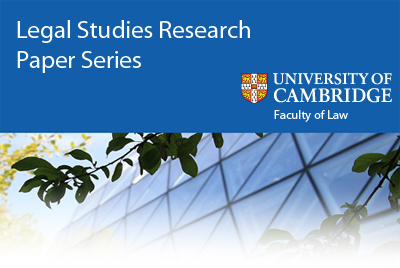 The Faculty has published Volume 8 Number 2 of the University of Cambridge Faculty of Law Legal Studies Research Paper Series on SSRN.
The Faculty has published Volume 8 Number 2 of the University of Cambridge Faculty of Law Legal Studies Research Paper Series on SSRN.
This issue includes the following articles:
Brian Sloan: Adoption Decisions in England: Re B (A Child) (Care Proceedings: Appeal) and Beyond (1/2017)
In Re B (A Child) (Care Proceedings: Appeal) [2013] UKSC 33 the Supreme Court President emphasised that ‘adoption of a child against her parents’ wishes should only be contemplated as a last resort – when all else fails’ because of adoption’s draconian nature. Re B has been cited dozens of times by the lower courts in the short time since it was decided. The aim of this article is to assess whether the influence of Re B is a matter of substance or mere rhetoric.
Paul Daly: The Signal and the Noise in Administrative Law (3/2016)
There has been an unfortunate trend in recent Supreme Court of Canada administrative law cases.
While academics, practitioners and lower-court judges try to establish coherent frameworks to understand the general principles of judicial review, the Court has been resolving cases one by one without, with respect, any serious attempt to explain how they fit into its existing body of jurisprudence. The institutional context in which the Court operates, explained in Part I, no doubt influences the Court’s resolution of individual cases in this way.
Whatever the background institutional context, confusion is the inevitable result, as I explain in Part II. How should lawyers read these cases: as attempts to resolve one-off issues of substantive law (workers’ compensation law, immigration law, discrimination law and so on) or as continual refinements to an already complex body of administrative law doctrine?
I argue in this paper that it is now necessary to distinguish between signal and noise, between those cases that do modify administrative law doctrine and those cases that simply deal with a particular substantive area of law. In Part III, I set out criteria which will help Canadian administrative lawyers to distinguish signal from noise.
This confusion seems to me, however, to be unnecessary. As I suggest in Part IV, the Court could take up judicial and academic proposals for a unified reasonableness standard that would allow it to resolve individual cases without creating uncertainty about whether it has also modified administrative law doctrine. Adopting this approach would obviate the need to distinguish signal from noise, because they would both fade into the comforting hum of reasonableness review.
Federica Paddeu: The Impact of Investment Arbitration on the Development of State Responsibility Defences (4/2017)
This chapter examines the impact that investment arbitration has had on the development of the defences in the law of State responsibility. In particular, it considers the impact of the practice and case-law of the 19th and early 20th centuries on the development of the plea of force majeure, currently codified in Article 23 ARS; the impact of investment arbitration since 2001 on the classification of state of necessity in Article 25 ARS as an excuse and on the (im)permissibility of countermeasures (Article 22 ARS) affecting private rights.
Johnathon E Liddicoat & Kathleen Liddell: Open Innovation with Large Bioresources: Goals, Challenges and Proposals (6/2017)
This report is from a Cambridge Workshop on the openness of large bioresources in synthetic biology and genomics (e.g. the 100,000 Genomes Project), held on 28 January 2016. Research in SB and Gx depends on the use of collections of tissue and data, commonly known as bioresources. Substantial amounts of time and money are being spent on creating these bioresources and it is likely that significant scientific breakthroughs and development of end-products may be missed or delayed if the tissue and data in these resources are not shared. Accordingly, the ‘openness’ of these bioresources — in other words, the ability for other researchers to access, use, and share these resources (which is typically recorded in a bioresource’s IP and access policy) — is a key issue for the success of bioresource initiatives and the progress of SB and Gx. There are, however, many different approaches to openness, and the development and dissemination of new knowledge are not necessarily advanced by distributing material at low cost or without any restrictions; time-limited rights of control (e.g. IP rights) may provide a useful incentive. It is a significant challenge to develop a fit-for-purpose openness policy that balances the advantages (and disadvantages) of different approaches to openness. The Workshop addressed this challenge by: reviewing openness policies adopted by large bioresources; eliciting ideas about access and intellectual property; debating the applicability of different openness policies; and identifying relevant areas for future research.
Interested readers can browse the Working Paper Series at SSRN, or sign up to subscribe to distributions of the the e-journal.


 Facebook
Facebook  X/Twitter
X/Twitter  Instagram
Instagram  YouTube
YouTube  Flickr
Flickr  LinkedIn
LinkedIn